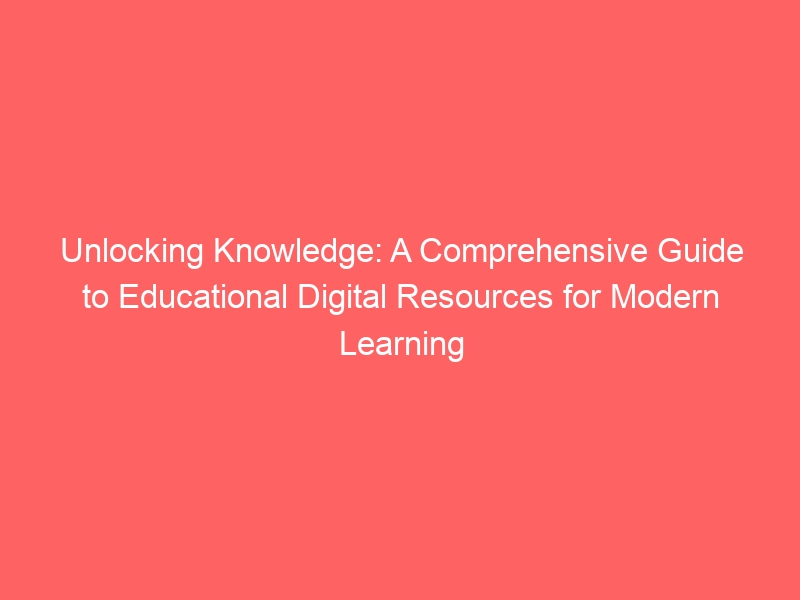Unlocking Knowledge: A Comprehensive Guide to Educational Digital Resources for Modern Learning
In an increasingly interconnected world, the landscape of education has transformed dramatically. The traditional classroom, while still vital, is now complemented, and often enhanced, by a vast array of educational digital resources. These powerful tools offer unprecedented access to knowledge, fostering lifelong learning, skill development, and personal growth for individuals across all ages and professions.
At OxFiles, where we empower secure and efficient testing through safe dummy files, we understand the critical role digital tools play in both practical application and foundational learning. This article delves into the world of educational digital resources, exploring their benefits, diverse categories, and how they can be leveraged to build a robust foundation for success in any field, including the intricate domains of security and performance testing.
The Transformative Power of Educational Digital Resources
Educational digital resources are not just a convenience; they represent a paradigm shift in how we acquire and disseminate knowledge. Their advantages are multifaceted:
* Unparalleled Accessibility: Geographic barriers are shattered. Learners from remote villages to bustling cities can access top-tier education with an internet connection, often regardless of their financial background.
* Flexibility and Self-Paced Learning: Digital resources empower individuals to learn at their own pace, on their own schedule. This is invaluable for working professionals, parents, or anyone juggling multiple commitments. You can pause, rewind, and revisit complex topics as needed.
* Enhanced Engagement and Interactivity: Unlike passive reading, many digital resources incorporate multimedia elements like videos, animations, interactive quizzes, simulations, and virtual labs, making the learning process more dynamic and memorable.
* Cost-Effectiveness: While some premium resources exist, a significant portion of high-quality educational content is available for free or at a much lower cost than traditional education, democratizing access to knowledge.
* Personalized Learning Paths: Digital platforms can often adapt to individual learning styles and progress, recommending resources and exercises tailored to specific needs and strengths, leading to more efficient learning outcomes.
* Up-to-Date Information: In rapidly evolving fields like technology, digital resources can be updated almost instantly, ensuring learners always have access to the latest information, methodologies, and best practices.
Key Categories of Educational Digital Resources
The spectrum of educational digital resources is incredibly broad, catering to diverse learning preferences and subject matters. Here are some of the most prominent categories:
Online Courses and Massive Open Online Courses (MOOCs)
These platforms offer structured learning experiences, often developed by universities and industry experts. MOOCs, in particular, provide free or low-cost access to university-level courses.
* Examples: Coursera, edX, Udemy, Udacity, Khan Academy.
* Benefits: Structured curriculum, expert instructors, peer interaction, often lead to certifications or degrees. They cover everything from introductory programming and data science to advanced cybersecurity principles and system performance optimization.
Digital Libraries and E-books
The digital age has brought entire libraries to our fingertips. E-books, academic journals, research papers, and archived materials are now readily accessible, often searchable, and portable.
* Examples: Project Gutenberg, Internet Archive, Google Books, university digital libraries, specialized technical e-book platforms.
* Benefits: Instant access to vast amounts of textual information, cost-effective (many classics are free), easy search functionality, environmentally friendly. Essential for deep dives into theoretical concepts or historical context in any field.
Educational Videos and Podcasts
For visual and auditory learners, these resources are invaluable. From short tutorials to in-depth documentaries and expert interviews, video and audio content can simplify complex topics and provide diverse perspectives.
* Examples: YouTube channels (e.g., freeCodeCamp, Crash Course, technical channels for programming or network security), educational podcasts (e.g., “Darknet Diaries” for cybersecurity, “Software Engineering Daily”).
* Benefits: Engaging format, often presented in an easy-to-understand manner, excellent for explaining complex processes or demonstrating software usage. Podcasts are perfect for learning on the go.
Interactive Learning Tools and Simulations
These resources allow learners to actively engage with the material, experiment, and apply concepts in a safe, controlled environment. This category is particularly crucial for technical fields.
* Examples: Coding sandboxes (e.g., CodePen, JSFiddle), virtual labs for networking or operating systems, scientific simulations, language learning apps, gamified educational platforms.
* Benefits: Hands-on experience, immediate feedback, risk-free experimentation, reinforces theoretical knowledge with practical application. For security and performance testing, these tools are indispensable for understanding vulnerabilities and system behavior.
Open Educational Resources (OER)
OER refers to freely accessible, openly licensed educational materials that can be used, adapted, and shared by anyone. This includes textbooks, course modules, videos, software, and any other tool or material used for learning.
* Examples: OER Commons, MIT OpenCourseWare, OpenStax.
* Benefits: Free access to high-quality academic content, flexibility to adapt materials for specific learning needs, promotes a global sharing of knowledge.
Specialized Learning Platforms and Communities
Beyond general platforms, many niche resources cater to specific skills or industries. These often combine various resource types and foster strong communities.
* Examples: GitHub for collaborative coding projects, Stack Overflow for Q&A, specialized forums for cybersecurity or database administration, platforms dedicated to specific software or programming languages.
* Benefits: Targeted learning, peer support, opportunities for real-world project contributions, direct access to expert insights.
Navigating the Digital Learning Landscape: Tips for Success
With the abundance of educational digital resources, effective navigation is key to maximizing your learning potential:
* Define Your Learning Goals: Before diving in, clearly articulate what you want to learn and why. This will help you filter through the vast options and choose the most relevant resources.
* Choose Reputable Sources: While many resources are excellent, the internet also contains misinformation. Prioritize content from established universities, recognized experts, industry leaders, or well-regarded educational platforms.
* Practice Active Learning: Don’t just passively consume content. Take notes
